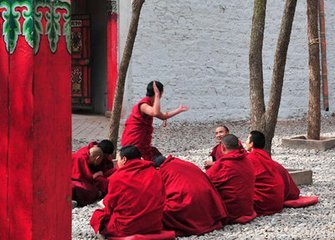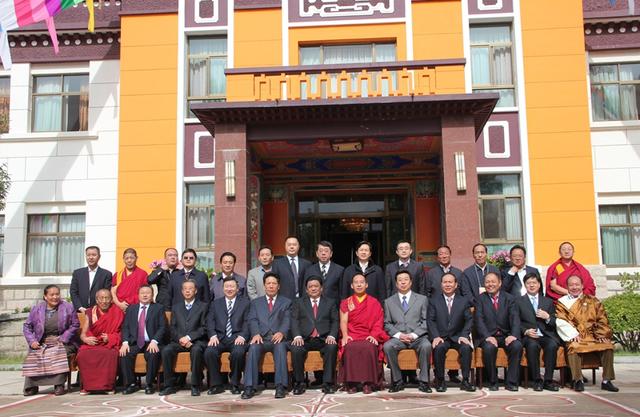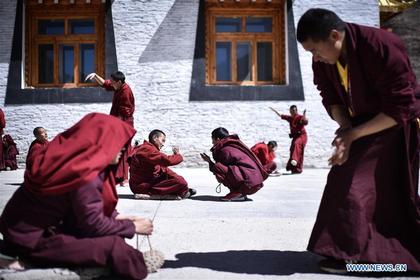The Monastery life of Tibetan Buddhist monks (2)
Every year during the 6th month of the Tibetan calendar from the 15th day up until the 30th day of July, Lhasahas entered the early summer season, vegetation is sprouting up and life is incubating. In order to avoid stepping on larvae and young birds the monastery demands that all of the monks live in seclusion within the monastery grounds, that they do not go out in furthermore that they conduct “ summertime quiet living”. On June 15th the first day of quiet living for the early summer begins and all of the monks must collect in the large gathering hall. Thereat they make an oath under the leadership of the head monk: that they will not go out and that they will not kill life. During the summertime quiet living period, every morning after praying all the monks will all return to their place of residence and close their doors to study. The leader of the Temple brings tea and porridge one by one to these monks throughout the monastery.
During this period on the 30th of June the monastery will celebrate the Lhasa Shonton Festival (Yogurt Banquet) which is held from the beginning of July up until July 5th, this festival is a custom for offering yogurt respectfully to the monks that are studying behind closed doors. On this day the Tibetan Opera group will perform Tibetan Opera and by the thousands believers, pilgrim and those designated by monks will come one after the other to the monastery to see the Tibetan Opera and also to offer respectfully yogurt to the monks studying. This is because during the summer quiet days period the monks will spend the entire day within the monastery grounds to study and they lack food and drink, those being designated by a monk and Believers feel very apologetic and therefore for this reason precisely people take cow's milk and produce yogurt and respectfully offer it to the monks.
From the first day of August in the Tibetan calendar the monastery will go into break for 15 days and many monks will happily leave the monastery and some will go into the forest for leisure while some will go to take showers and others will take part in outdoor picnics, some will sing while others will dance and others will even perform Tibetan Opera. Other than this many will also participate in various kinds of physical competitions.
Every year during the winter and the summer debate activities are separately conducted in Sangpu Monastray and Rato Monastray. The studying monks will go through a series of sutra chants, study classics and debate them, thereafter they will know well the classic scriptures. At this time they are able to participate in each level of debates in the monastery and those that have tests will gradually be allowed to participate in the large assembly debate held in Lhasa.
Degrees of Tibetan Buddhism studies can be divided into several levels and each of these degrees are generally termed as Geshe. The first level of these degrees is called the Larampa Geshe, which is determined by passing a debate in front of the Chuangzhao large Buddhist assembly; the second one is called the Tsorampa Geshe, which is granted by passing the Chuangzhao small Buddhist assembly; the third level of the Geshe is the Dorampa Geshe, which the discussion test for is conducted within the monastery itself; the 4th level is called the Lingshi Geshe, which is conducted by dissertation within the Raseng on the monastary itself.
Your Comment
Name E-mailRelated News
-
;
-
-

-
The Monastery life of Tibetan Buddhist monks (1)
The monastery is the world of the monk. The temple life of Tibetan Buddhist monks is special and unique.
-
-
-

-
The Panchen Lama invites high-ranking monks to learn Tibet via WeC
On May 17th, the 11th Panchen Lama Gyaincain Norbu arrived in Lhasa, capital city of SW China's Tibet Autonomous Region by charter plane for research studies and Buddhist ceremonies.
-
-
-

-
Monks debate on Tibetan Buddhism doctrines in NW China
Monks debate on Tibetan Buddhism doctrines at Labu Monastery in Yushu Tibetan Autonomous Prefecture, northwest China's Qinghai Province, April 18, 2016.
-
-
-

-
11 monks obtain highest academic degree of Tibetan Buddhism
Eleven monks received the certificates of Lharamspa degree at the Jokhang Temple in Lhasa on April 10.
-
Based in Lhasa, Tibet Vista is a Tibet travel agency that specialized in Tibet permit, and Tibet tours for both private and group travelers at a local price!
•4 Days Lhasa City Group Tour from USD 460 •8 Days Everest Base Camp Group Tour from USD 850 •15 Days Mt.Kailash Group Tour from USD 1780 •2016 Tibet Train Tours from Beijing, Shanghai, Chengdu, Xining,etc










